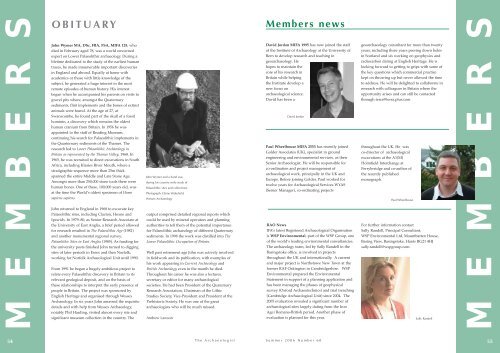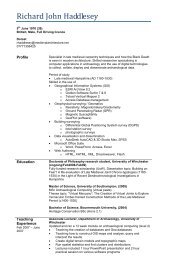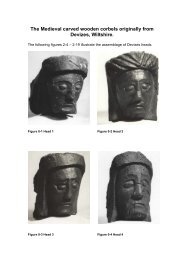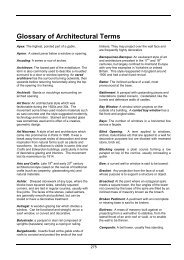The ARCHAEOLOGIST - English Late-Medieval timber-framed ...
The ARCHAEOLOGIST - English Late-Medieval timber-framed ...
The ARCHAEOLOGIST - English Late-Medieval timber-framed ...
You also want an ePaper? Increase the reach of your titles
YUMPU automatically turns print PDFs into web optimized ePapers that Google loves.
M E M B E R S<br />
OBITUARY<br />
John Wymer MA, DSc, FBA, FSA, MIFA 129, who<br />
died in February aged 78, was a world renowned<br />
expert on Lower Palaeolithic archaeology. During a<br />
lifetime dedicated to the study of the earliest human<br />
traces, he made innumerable important discoveries<br />
in England and abroad. Equally at home with<br />
academics or those with little knowledge of the<br />
subject, he generated a huge interest in the most<br />
remote episodes of human history. His interest<br />
began when he accompanied his parents on visits to<br />
gravel pits where, amongst the Quaternary<br />
sediments, flint implements and the bones of extinct<br />
animals were found. At the age of 27, at<br />
Swanscombe, he found part of the skull of a fossil<br />
hominin, a discovery which remains the oldest<br />
human cranium from Britain. In 1956 he was<br />
appointed to the staff of Reading Museum,<br />
continuing his search for Palaeolithic implements in<br />
the Quarternary sediments of the Thames. <strong>The</strong><br />
research led to Lower Palaeolithic Archaeology in<br />
Britain as represented by the Thames Valley, 1968. In<br />
1965, he was recruited to direct excavations in South<br />
Africa, including Klasies River Mouth, where a<br />
stratigraphic sequence more than 25m thick<br />
spanned the entire Middle and <strong>Late</strong> Stone Age.<br />
Amongst more than 250,000 stone tools there were<br />
human bones. One of these, 100,000 years old, was<br />
at the time the World’s oldest specimen of Homo<br />
sapiens sapiens.<br />
John returned to England in 1968 to excavate key<br />
Palaeolithic sites, including Clacton, Hoxne and<br />
Ipswich. In 1979–80, as Senior Research Associate at<br />
the University of East Anglia, a brief period allowed<br />
for research resulted in <strong>The</strong> Palaeolithic Age (1982)<br />
and another monumental regional survey,<br />
Palaeolithic Sites in East Anglia (1985). As funding for<br />
the university posts finished John turned to digging<br />
sites of later periods in Essex and then Norfolk,<br />
working for Norfolk Archaeological Unit until 1990.<br />
From 1991 he began a hugely ambitious project to<br />
relate every Palaeolithic discovery in Britain to its<br />
relevant geological deposit, and on the basis of<br />
these relationships to interpret the early presence of<br />
people in Britain. <strong>The</strong> project was sponsored by<br />
<strong>English</strong> Heritage and organised through Wessex<br />
Archaeology. In six years John amassed the requisite<br />
details and with help from Wessex Archaeology,<br />
notably Phil Harding, visited almost every site and<br />
significant museum collection in the country. <strong>The</strong><br />
John Wymer and a hand axe,<br />
during his country-wide study of<br />
Palaeolithic sites and collections.<br />
Photograph: Elaine Wakefield,<br />
Wessex Archaeology<br />
output comprised detailed regional reports which<br />
could be used by mineral operators and planning<br />
authorities to tell them of the potential importance<br />
for Palaeolithic archaeology of different Quaternary<br />
sediments. In 1998 the work was distilled into <strong>The</strong><br />
Lower Palaeolithic Occupation of Britain.<br />
Well past retirement age John was actively involved<br />
in fieldwork and its publication, with examples of<br />
his work appearing in Current Archaeology and<br />
British Archaeology even in the month he died.<br />
Throughout his career he was also a lecturer,<br />
secretary or editor for many archaeological<br />
societies. He had been President of the Quaternary<br />
Research Association, Chairman of the Lithic<br />
Studies Society, Vice-President and President of the<br />
Prehistoric Society. He was one of the great<br />
archaeologists who will be much missed.<br />
Andrew Lawson<br />
Members news<br />
David Jordan MIFA 1995 has now joined the staff<br />
of the Institute of Archaeology at the University of<br />
Bern to develop research and teaching in<br />
geoarchaeology. He<br />
hopes to maintain the<br />
core of his research in<br />
Britain while helping<br />
the Institute develop a<br />
new focus on<br />
archaeological science.<br />
David has been a<br />
David Jordan<br />
Paul Wheelhouse MIFA 2553 has recently joined<br />
Golder Associates (UK), specialist in ground<br />
engineering and environmental services, as their<br />
Senior Archaeologist. He will be responsible for<br />
co-ordination and project management of<br />
archaeological work, principally in the UK and<br />
Europe. Before joining Golder, Paul worked for<br />
twelve years for Archaeological Services WYAS<br />
(Senior Manager), co-ordinating projects<br />
RAO News<br />
IFA’s latest Registered Archaeological Organisation<br />
is WSP Environmental, part of the WSP Group, one<br />
of the world’s leading environmental consultancies.<br />
<strong>The</strong> archaeology team, led by Sally Randell in the<br />
Basingstoke office, is involved in projects<br />
throughout the UK and internationally. A current<br />
and major project is Northstowe New Town at the<br />
former RAF Oakington in Cambridgeshire. WSP<br />
Environmental prepared the Environmental<br />
Statement in support of a planning application and<br />
has been managing the phases of geophysical<br />
survey (Oxford Archaeotechnics) and trial trenching<br />
(Cambridge Archaeological Unit) since 2004. <strong>The</strong><br />
2005 evaluation revealed a significant number of<br />
archaeological sites largely dating from the Iron<br />
Age/Romano-British period. Another phase of<br />
evaluation is planned for this year.<br />
geoarchaeology consultant for more than twenty<br />
years, including three years peering down holes<br />
in Scotland and six working on geophysics and<br />
radiocarbon dating at <strong>English</strong> Heritage. He is<br />
looking forward to getting to grips with some of<br />
the key questions which commercial practice<br />
kept on throwing up but never allowed the time<br />
to address. He will be delighted to collaborate in<br />
research with colleagues in Britain where the<br />
opportunity arises and can still be contacted<br />
through terra@terra.plus.com<br />
throughout the UK. He was<br />
co-director of archaeological<br />
excavations at the A1(M)<br />
Holmfield Interchange at<br />
Ferrybrridge and co-author of<br />
the recently published<br />
monograph.<br />
Paul Wheelhouse<br />
For further information contact<br />
Sally Randell, Principal Consultant,<br />
WSP Environmental Ltd, Mountbatten House,<br />
Basing View, Basingstoke, Hants RG21 4HJ<br />
sally.randell@wspgroup.com.<br />
Sally Randell<br />
M E M B E R S<br />
54<br />
<strong>The</strong> Archaeologist<br />
Summer 2006 Number 60<br />
55





